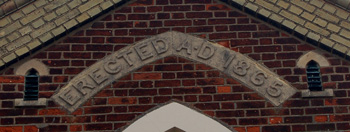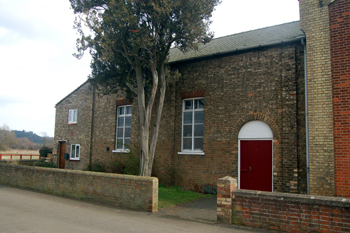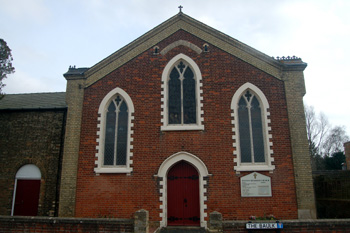Methodists in Beeston

The Methodist Church March 2010
The first mention of Methodists in Beeston is in September 1797 when the society is mentioned in the Saint Neots Wesleyan Circuit Steward's account book [MB1346]. In 1797 John Cooper and James Schofield registered Cooper's dwelling house at Beeston as a nonconformist meeting [ABN1/1, ABN2/79] and, though the denomination is not mentioned, the coincidence of dates argues that this was the Methodist meeting. Beeston is last mentioned in the Circuit Steward's account book in 1810.
A pamphlet called Centenary of the Building of the Present Methodist Chapel published in 1965 quotes the Biggleswade Chronicle in describing the early years of Methodism in Beeston: "Apparently in the 1820's, a few members met in a cottage on Beeston Green, to reach which, a plank over a brook had to be crossed. This plank, to our early Methodits, was a continual source of danger, for often, as members crossed the Green with the aid of lanterns on a dark evening, string would be found tied across the plank. Consequently, those who neglected the precaution of carrying a lantern, would fall victim to the mischievous youths of the village. This same spirit of opposition led to the introduction of several sparrows into the room in which meetings were being he;d, with the result that many services were finished in total darkness".

The date of the Methodist Church March 2010
The Methodist chapel at The Baulk in Beeston carries the date 1865, leading one to presume that it was built in that year. However, as is frequently the case with local history, things are not necessarily so clear cut.
Some years ago title deeds were brought into Bedfordshire and Luton Archives and Records Service and the information extracted by office staff before the owner took them away again [CRT170/6/6]. An abstract of title stated that on 29th October 1832 Robert Barker of Beeston, shopkeeper, conveyed land to: Richard Bird of Beeston, farmer; Thomas Bean of Beeston, gardener; William Conquest of Biggleswade, glazier; Samuel Cocking of Biggleswade, gardener; Griffin Cant of Upper Caldecote, farmer [part of whose house in Caldecote was registered as a Wesleyan meeting in 1832]; William Farrington of Biggleswade, cordwainer [shoemaker]; this Hine of Newnham [Hertfordshire], farmer; Thomas Powers of Biggleswade, ironmonger and Charles Smith of Potton, flour factor. These men were trustees for "The Society of People called Methodists late in connection with the Reverend John Wesley, deceased, assembling at Beeston aforesaid and which said Society are about to Erect and build a Chapel or Meeting House upon the said parcel of Land". This parcel was described as comprising 10 poles, being 67 feet east-west and 42 feet north-south. It was bounded east and north by landof Mrs. Ayresand west and south by other landof Robert Barker. The inclosure map of 1783 shows land in the area of The Baulk, and thus the present building owned by someone named Ayres and a T. Walker. The abstract noted above states that Thomas Walker's land was conveyed to S. Bone in 1813. He immediately resold it to T. Daniel and he sold to Robert Barker in 1827.
In the centenary pamphlet quoted above there is a photograph of the left hand side of the current chapel which is described as being the old chapel. This clearly suggests that the 1832 building was added to by the striking building dated to 1865; certainly the two structures are built of quite different materials.

The old chapel in March 2010
Beeston formed part of the Biggleswade and Hitchin Circuit from the time the chapel was built until 1842 when it became part of the Biggleswade Wesleyan Circuit. Early Circuit Baptism Registers covering Beeston are at Hertfordshire Archives Service [NM4/52].
The secular authorities wished to know how many people in the country attended worship and the rough proportions for each denomination. Thus a census of worshippers was held on Sunday 30th March 1851, known as the Ecclesiastical Census. It was not a particularly popular exercise and the day itself, cold, wet and unpleasant, did not exactly encourage people to go outdoors. Nevertheless, John Sargeant, the chapel steward, recorded that 140 adults and 118 Sunday scholars turned out that morning. 273 adults and 127 scholars came in the afternoon and a general congregation of 258 in the evening. Clearly this was a very thriving concern.
The steward noted that the chapel dated to 1832, which corresponds to the deed described above. It had 165 free seats and another 180 reserved. The Wesleyan chapel was registered on 9th February 1854by Robert Maxwell of Biggleswade, the minister. This was cancelled in 1876.
In 1859, as related by the centenary pamphlet, a trust was created to build an addition to the chapel and Barker again conveyed land, for £80. It took some time to raise the funds to build the new chapel which was completed in 1865 and registered on 21st July 1868by John Carey Pengelly of Biggleswade, minister. The chapel was registered as a wedding venue in 1870. Bedfordshire and Luton Archives and Records Service has five marriage registers from the chapel dated 1926 to 1988. They were in a safe stolen from the chapel in 1991 and, whilst they were subsequently recovered they were badly damaged by water and so are unfit for production. However, the service has microfilmed copies which may be consulted [Micf114].
The new chapel contained three hundred seats and the old chapel was then used as a schoolroom. The centenary pamphlet states that the first child to be baptised in the new chapel was Elizabeth, daughter of Samuel and Annie Sharpe of Ampthill on 22nd June 1869. In 1882 two vestries and an organ chamber were added to the new chapel, with a new organ being purchased in 1893, this was replaced in 1915. Electric light was installed in 1927.
In 1932 the Wesleyan Methodists came together with the Primitive Methodists and United Methodists to form the unified Methodist Church of Great Britain, which it remains. A programme of renovation was carried out in the early 1960s. At the time of writing [2010] the Methodist chapel at Beeston remains a place of worship.

The Methodist Church from the front March 2010
Bedfordshire and Luton Archives and Records Service has the following records relating to Beeston:
-
MB1346: Saint Neots Circuit Steward's account book: 1793-1832;
-
MB1423: Register of Biggleswade Circuit deeds, certificates, insurance policies etc., inch Beeston deeds 1832-1869;
-
MB834: Biggleswade and Hitchin Wesleyan Circuit schedule book: 1838-1852;
-
MB840: Biggleswade Wesleyan Circuit baptism register: 1838-1851;
-
MB841: Biggleswade Wesleyan Circuit baptism register: 1851-1859
-
MB835: Biggleswade Wesleyan Circuit schedule book: 1852-1860;
-
MB842: Biggleswade Wesleyan Circuit baptism register: 1859-1872;
-
MB836: Biggleswade Wesleyan Circuit schedule book: 1861-1870;
-
MB839: Biggleswade Wesleyan Circuit Sunday School schedules: 1869-1874;
-
MB843: Biggleswade Wesleyan Circuit baptism register: 1872-1897;
-
MB1400: mentioned in a letter
-
MB845: Biggleswade Wesleyan Circuit baptism register: 1897-1947;
-
MB1628: Beeston Chapel Trustees' Minute Book: 1907-1940;
-
MB1687: Biggleswade Circuit Sunday School Union Council minute book: 1921-1938;
-
MB1911/1: Beeston Chapel marriage register: 1926-1932;
-
MB1911/2: Beeston Chapel marriage register: 1932-1944;
-
MB837: Biggleswade Wesleyan Circuit schedule book: 1936-1955;
-
MB1427: Beeston Chapel Leaders' Meeting Minute Book: 1936-1978;
-
MB1911/3: Beeston Chapel marriage register: 1944-1955;
-
MB1911/4: Beeston Chapel marriage register: 1955-1974;
-
MB835: Biggleswade Wesleyan Circuit schedule book: 1956-1966;
-
MB1424: List of Biggleswade Circuit chapel trustees: 1965;
-
MB1426: Copies of Sectional Roundabout quarterly newsletter for Beeston, Mogerhanger, Everton, Gamlingay Heath and Potton: 1969-1973;
-
MB1911/5: Beeston Chapel marriage register: 1975-1988.